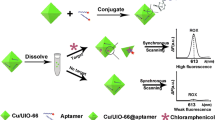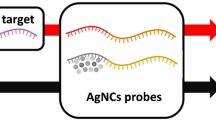Abstract
Gold nanoparticles (AuNPs) conjugated with Cy3-tagged aptamer which can specifically recognize chloramphenicol (CAP) (referred to as AuNPs-AptCAP) are described. CAP can trigger the configuration change of CAP binding aptamer, and thus switching the fluorescence of AuNPs-AptCAP through changing the efficiency of the fluorescence resonance energy transfer (FRET) system with Cy3 as donors and AuNPs as recipients. AuNPs-AptCAP exhibits a linear range of CAP concentrations from 26.0 to 277 μg L−1 with a limit of detection of 8.1 μg L−1 when Cy3 was excited at 530 nm and emission was measured at 570 nm. More importantly, AuNPs-AptCAP can be utilized as signal transducers for the build-up of a series of logic gates including YES, PASS 0, INH, NOT, PASS 1, and NAND. Utilizing the principle of a metal ion–mediated fluorescence switch together with a strong metal ion chelator, the fluorescence of AuNPs-AptCAP could be modulated by adding metal ions and EDTA sequentially. Therefore, a “Plug and Play” logic system based on AuNPs-AptCAP has been realized by simply adding other components to create new logic functions. This work highlights the advantages of simple synthesis and facile fluorescence switching properties, which will provide useful knowledge for the establishment of molecular logic systems.

Graphical abstract






Similar content being viewed by others
References
de Silva AP, Uchiyama S (2007) Molecular logic and computing. Nat Nanotechnol 2(7):399–410. https://doi.org/10.1038/nnano.2007.188
Szacilowski K (2008) Digital information processing in molecular systems. Chem Rev 108(9):3481–3548. https://doi.org/10.1021/cr068403q
Tregubov AA, Nikitin PI, Nikitin MP (2018) Advanced smart nanomaterials with integrated logic-gating and biocomputing: dawn of theranostic nanorobots. Chem Rev 118(20):10294–10348. https://doi.org/10.1021/acs.chemrev.8b00198
Pischel U (2007) Chemical approaches to molecular logic elements for addition and subtraction. Angew Chem Int Ed 46(22):4026–4040. https://doi.org/10.1002/anie.200603990
Pu F, Ren J, Qu X (2014) Nucleic acids and smart materials: advanced building blocks for logic systems. Adv Mater 26(33):5742–5757. https://doi.org/10.1002/adma.201401617
Seelig G, Soloveichik D, Zhang DY, Winfree E (2006) Enzyme-free nucleic acid logic circuits. Science. 314(5805):1585–1588. https://doi.org/10.1126/science.1132493
Liu D, Chen W, Sun K, Deng K, Zhang W, Wang Z, Jiang X (2011) Resettable, multi-readout logic gates based on controllably reversible aggregation of gold nanoparticles. Angew Chem Int Ed 50(18):4103–4107. https://doi.org/10.1002/anie.201008198
Chen X, Wang YF, Liu Q, Zhang ZZ, Fan CH, He L (2006) Construction of molecular logic gates with a DNA-cleaving deoxyribozyme. Angew Chem Int Ed 45(11):1759–1762. https://doi.org/10.1002/anie.200502511
Deng M, Yang M, Xu Y, Sun Y, Wang Q, Liu J, Huang J, Yang X, Wang K (2019) Biomimetic nanochannel membrane for cascade response of borate and cis-hydroxyl compounds: an IMP logic gate device. Chin Chem Lett 30(7):1397–1400. https://doi.org/10.1016/j.cclet.2019.04.003
Qu DH, Wang QC, Tian H (2005) A half adder based on a photochemically driven 2 rotaxane. Angew Chem Int Ed 44(33):5296–5299. https://doi.org/10.1002/anie.200501215
Langford SJ, Yann T (2003) Molecular logic: a half-subtractor based on tetraphenylporphyrin (vol 125, 11198, 2003). J Am Chem Soc 125(48):14951–14951. https://doi.org/10.1021/ja038843o
Margulies D, Melman G, Shanzer A (2006) A molecular full-adder and full-subtractor, an additional step toward a moleculator. J Am Chem Soc 128(14):4865–4871. https://doi.org/10.1021/ja058564w
Credi A (2007) Molecules that make decisions. Angew Chem Int Ed 46(29):5472–5475. https://doi.org/10.1002/anie.200700879
Pan Y, Shi Y, Chen Z, Chen J, Hou M, Chen Z, Li C-W, Yi C (2016) Design of multiple logic gates based on chemically triggered fluorescence switching of functionalized polyethylenimine. ACS Appl Mater Interfaces 8(14):9472–9482. https://doi.org/10.1021/acsami.6b02080
de Silva AP, Dobbin CM, Vancea TP, Wannalerse B (2009) Multiply reconfigurable ‘plug and play’ molecular logic via self-assembly. Chem Commun 11:1386–1388. https://doi.org/10.1039/b822181b
Shanley T (1995) Plug and play system architecture
Auslaender S, Auslaender D, Mueller M, Wieland M, Fussenegger M (2012) Programmable single-cell mammalian biocomputers. Nature 487:123–127. https://doi.org/10.1038/nature11149
Pu F, Ren J, Qu X (2014) “Plug and Play” logic gates based on fluorescence switching regulated by self-assembly of nucleotide and lanthanide ions. ACS Appl Mater Interfaces 6(12):9557–9562. https://doi.org/10.1021/am501949t
Chang X, Zhang C, Lv C, Sun Y, Zhang M, Zhao Y, Yang L, Han D, Tan W (2019) Construction of a multiple-aptamer-based DNA logic device on live cell membranes via associative toehold activation for accurate cancer cell identification. J Am Chem Soc 141(32):12738–12743. https://doi.org/10.1021/jacs.9b05470
Yang J, Jiang S, Liu X, Pan L, Zhang C (2016) Aptamer-binding directed DNA origami pattern for logic gates. ACS Appl Mater Interfaces 8(49):34054–34060. https://doi.org/10.1021/acsami.6b10266
Wang L, Zhu J, Han L, Jin L, Zhu C, Wang E, Dong S (2012) Graphene-based aptamer logic gates and their application to multiplex detection. ACS Nano 6(8):6659–6666. https://doi.org/10.1021/nn300997f
Shukoor MI, Altman MO, Han D, Bayrac AT, Ocsoy I, Zhu Z, Tan W (2012) Aptamer-nanoparticle assembly for logic-based detection. ACS Appl Mater Interfaces 4(6):3007–3011. https://doi.org/10.1021/am300374q
Zhou M, Du Y, Chen C, Li B, Wen D, Dong S, Wang E. (2010) Aptamer-controlled biofuel cells in logic systems and used as self-powered and intelligent logic aptasensors. J Am Chem Soc.132(7):2172−+. doi:https://doi.org/10.1021/ja910634e
Tuerk C, Gold L (1990) Systematic evolution of ligands by exponential enrichment: RNA ligands to bacteriophage T4 DNA polymerase. Science (New York, NY) 249(4968):505–510. https://doi.org/10.1126/science.2200121
Shi Q, Shi Y, Pan Y, Yue Z, Zhang H, Yi C (2015) Colorimetric and bare eye determination of urinary methylamphetamine based on the use of aptamers and the salt-induced aggregation of unmodified gold nanoparticles (vol 182, pg 505, 2015). Microchim Acta 182(3–4):513–513. https://doi.org/10.1007/s00604-014-1396-1
Kuang L, Cao S-P, Zhang L, Li Q-H, Liu Z-C, Liang R-P, Qiu J-D (2016) A novel nanosensor composed of aptamer bio-dots and gold nanoparticles for determination of thrombin with multiple signals. Biosens Bioelectron 85:798–806. https://doi.org/10.1016/j.bios.2016.05.096
Li L, Liu Z, Zhang H, Yue W, Li C-W, Yi C (2018) A point-of-need enzyme linked aptamer assay for Mycobacterium tuberculosis detection using a smartphone. Sensors Actuators B Chem 254:337–346. https://doi.org/10.1016/j.snb.2017.07.074
Robati RY, Arab A, Ramezani M, Langroodi FA, Abnous K, Taghdisi SM (2016) Aptasensors for quantitative detection of kanamycin. Biosens Bioelectron 82:162–172. https://doi.org/10.1016/j.bios.2016.04.011
Qu H, Csordas AT, Wang J, Oh SS, Eisenstein MS, Soh HT (2016) Rapid and label-free strategy to isolate aptamers for metal ions. ACS Nano 10(8):7558–7565. https://doi.org/10.1021/acsnano.6b02558
Liu Z, Zhang Y, Xu S, Zhang H, Tan Y, Ma C, Song R, Jiang L, Yi C (2017) A 3D printed smartphone optosensing platform for point-of-need food safety inspection. Anal Chim Acta 966:81–89. https://doi.org/10.1016/j.aca.2017.02.022
Hu Z, Jian J, Hua Y, Yang D, Gao Y, You J, Wang Z, Chang Y, Yuan K, Bao Z, Zhang Q, Li S, Jiang Z, Zhou H (2018) DNA colorimetric logic gate in microfluidic chip based on unmodified gold nanoparticles and molecular recognition. Sensors Actuators B Chem 273:559–565. https://doi.org/10.1016/j.snb.2018.06.073
Yang J, Song Z, Liu S, Zhang Q, Zhang C (2016) Dynamically arranging gold nanoparticles on DNA origami for molecular logic gates. ACS Appl Mater Interfaces 8(34):22451–22456. https://doi.org/10.1021/acsami.6b04992
Li Y, Li W, He K-Y, Li P, Huang Y, Nie Z, Yao S-Z (2016) A biomimetic colorimetric logic gate system based on multi-functional peptide-mediated gold nanoparticle assembly. Nanoscale. 8(16):8591–8599. https://doi.org/10.1039/c6nr01072e
de la Rosa VR, Zhang Z, De Geest BG, Hoogenboom R (2015) Colorimetric logic gates based on poly(2-alkyl-2-oxazoline)coated gold nanoparticles. Adv Funct Mater 25(17):2511–2519. https://doi.org/10.1002/adfm.201404560
Meng T-T, Liu Y-X, Liu M-T, Long J-B, Cao Q-F, Yan S-Y, Meng X-X (2015) Lineal DNA logic gate for microRNA diagnostics with strand displacement and fluorescence resonance energy transfer. Chin Chem Lett 26(9):1179–1182. https://doi.org/10.1016/j.cclet.2015.05.039
Su S, Sun H, Cao W, Chao J, Peng H, Zuo X, Yuwen L, Fan C, Wang L (2016) Dual-target electrochemical biosensing based on DNA structural switching on gold nanoparticle-decorated MoS2 nanosheets. ACS Appl Mater Interfaces 8(11):6826–6833. https://doi.org/10.1021/acsami.5b12833
Qin C, Gao Y, Wen W, Zhang X, Wang S (2016) Visual multiple recognition of protein biomarkers based on an array of aptamer modified gold nanoparticles in biocomputing to strip biosensor logic operations. Biosens Bioelectron 79:522–530. https://doi.org/10.1016/j.bios.2015.12.096
Wang J, Lu J, Su S, Gao J, Huang Q, Wang L, Huang W, Zuo X (2015) Binding-induced collapse of DNA nano-assembly for naked-eye detection of ATP with plasmonic gold nanoparticles. Biosens Bioelectron 65:171–175. https://doi.org/10.1016/j.bios.2014.10.031
Zhang Y, Qi S, Liu Z, Shi Y, Yue W, Yi C (2016) Rapid determination of dopamine in human plasma using a gold nanoparticle-based dual-mode sensing system. Mater Sci Eng C 61:207–213. https://doi.org/10.1016/j.msec.2015.12.038
Xu X, Zhang J, Yang F, Yang X (2011) Colorimetric logic gates for small molecules using split/integrated aptamers and unmodified gold nanoparticles. Chem Commun 47(33):9435–9437. https://doi.org/10.1039/c1cc13459k
Grabar KC, Freeman RG, Hommer MB, Natan MJ (1995) Preparation and characterization of Au colloid monolayers. Anal Chem 67:735–743. https://doi.org/10.1021/ac00100a008‚
Mehta J, Van Dorst B, Rouah-Martin E, Herrebout W, Scippo M-L, Blust R, Robbens J (2011) In vitro selection and characterization of DNA aptamers recognizing chloramphenicol. J Biotechnol 155(4):361–369. https://doi.org/10.1016/j.jbiotec.2011.06.043
Shi Y, Zhang H, Yue Z, Zhang Z, Teng K-S, Li M-J, Yi C, Yang M (2013) Coupling gold nanoparticles to silica nanoparticles through disulfide bonds for glutathione detection. Nanotechnology. 24(37):375501. https://doi.org/10.1088/0957-4484/24/37/375501
Kim Y-P, Oh Y-H, Oh E, Ko S, Han M-K, Kim H-S (2008) Energy transfer-based multiplexed assay of proteases by using gold nanoparticle and quantum dot conjugates on a surface. Anal Chem 80(12):4634–4641. https://doi.org/10.1021/ac702416e
Zu F, Yan F, Bai Z, Xu J, Wang Y, Huang Y, Zhou X (2017) The quenching of the fluorescence of carbon dots: a review on mechanisms and applications. Microchim Acta 184(7):1899–1914. https://doi.org/10.1007/s00604-017-2318-9
Shi Y, Yi C, Zhang Z, Zhang H, Li M, Yang M, Jiang Q (2013) Peptide-bridged assembly of hybrid nanomaterial and its application for caspase-3 detection. ACS Appl Mater Interfaces 5(14):6494–6501. https://doi.org/10.1021/am401935y
Phan AT, Kuryavyi V, Patel DJ (2006) DNA architecture: from G to Z. Curr Opin Struct Biol 16(3):288–298. https://doi.org/10.1016/j.sbi.2006.05.011
Meggers E, Holland PL, Tolman WB, Romesberg FE, Schultz PG (2000) A novel copper-mediated DNA base pair. J Am Chem Soc 122(43):10714–10715. https://doi.org/10.1021/ja0025806
Daniel SCGK, Kumar A, Sivasakthi K, Thakur CS (2019) Handheld, low-cost electronic device for rapid, real-time fluorescence-based detection of Hg2+, using aptamer-templated ZnO quantum dots. Sensors Actuators B Chem 290:73–78. https://doi.org/10.1016/j.snb.2019.03.113
Zhan S, Wu Y, Wang L, Zhan X, Zhou P (2016) A mini-review on functional nucleic acids-based heavy metal ion detection. Biosens Bioelectron 86:353–368. https://doi.org/10.1016/j.bios.2016.06.075
Huang J, Su X, Li Z (2017) Metal ion detection using functional nucleic acids and nanomaterials. Biosens Bioelectron 96:127–139. https://doi.org/10.1016/j.bios.2017.04.032
Demers LM, Mirkin CA, Mucic RC, Reynolds RA, Letsinger RL, Elghanian R, Viswanadham G (2000) A fluorescence-based method for determining the surface coverage and hybridization efficiency of thiol-capped oligonucleotides bound to gold thin films and nanoparticles. Anal Chem 72(22):5535–5541. https://doi.org/10.1021/ac0006627
Hurst SJ, Lytton-Jean AKR, Mirkin CA (2006) Maximizing DNA loading on a range of gold nanoparticle sizes. Anal Chem 78(24):8313–8318. https://doi.org/10.1021/ac0613582
Zanchet D, Micheel CM, Parak WJ, Gerion D, Alivisatos AP (2001) Electrophoretic isolation of discrete Au nanocrystal/DNA conjugates. Nano Lett 1(1):32–35. https://doi.org/10.1021/nl005508e
Cao X-H, Wang Q, Li J, Yi C, Li M-J (2017) Gold nanoparticles functionalized with Ru(II)bipyridyl labeled DNA as a luminescent probe for the sensitive determination of DNase I. Microchim Acta 184(9):3273–3279. https://doi.org/10.1007/s00604-017-2330-0
Rose PW, Hamden A, Brueggemann AB, Perera R, Sheikh A, Crook D, Mant D (2005) Chloramphenicol treatment for,acute infective conjunctivitis in children in primary care: a randomised double-blind placebo-controlled trial. Lancet. 366(9479):37–43. https://doi.org/10.1016/s0140-6736(05)66709-8
Suarez CR, Ow EP (1992) Chloramphenicol toxicity associated with severe cardiac dysfunction. Pediatr Cardiol 13(1):48–51
No. 235 of the Ministry of Agriculture of the People's Republic of China, 2002, http://jiuban.moa.gov.cn/zwllm/ tzgg/gg/200302/P0200506
Commission Decision of 13 (2003) http://data.europa.eu/eli/dec/2003/181(1)/oj
Giri AS, Golder AK (2014) Chloramphenicol degradation in Fenton and photo-Fenton: formation of Fe2+-chloramphenicol chelate and reaction pathways. Ind Eng Chem Res 53(42):16196–16203. https://doi.org/10.1021/ie501508d
Funding
The financial support from Guangdong Natural Science Foundation (S2017A030313076), Shenzhen Basic Research Program (JCYJ20170307140752183), and Science and Technology Project of Guangzhou (201803020026) is received.
Author information
Authors and Affiliations
Corresponding author
Ethics declarations
Conflict of interest
The authors declare that they have no competing of interests.
Additional information
Publisher’s note
Springer Nature remains neutral with regard to jurisdictional claims in published maps and institutional affiliations.
Electronic supplementary material
ESM 1
(DOCX 1421 kb)
Rights and permissions
About this article
Cite this article
Zhang, Y., Li, CW., Zhou, L. et al. “Plug and Play” logic gate construction based on chemically triggered fluorescence switching of gold nanoparticles conjugated with Cy3-tagged aptamer. Microchim Acta 187, 437 (2020). https://doi.org/10.1007/s00604-020-04421-5
Received:
Accepted:
Published:
DOI: https://doi.org/10.1007/s00604-020-04421-5




